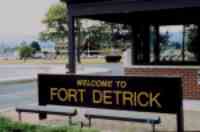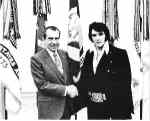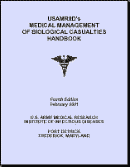
Click on any Country below,
or click on the upward pointing arrow to go to the Main page of the article.





The US program :
The US biological weapons program was kicked off around 1941-42 probably with
some assistance of Japanese scientists from Unit 731 (See "History of
Biological Warfare" to read more about Unit731). The organization carrying
out the research was known as the Chemical warfare service or CWS.
The largest and most secretive of the US research facilities was in Fort Detrick in
Maryland. The facility was built in 1943, with the substantial help
and guidance of George Merck, president of the Merck & Co.
pharmaceutical company.( Yup, the same pharmaceutical company that publishes the
Merck manual now). At the time that it started, Fort Detrick had 4000 employees.
This facility was later renamed as USAMRIID ( US Army Medical Research Institute
of Infectious diseases). Even today, USAMRIID remains the top institute for
biological weapons research in the US, however the research being carried out
now is widely believed to be only defensive in nature.



Images:
Please click to view larger versions.
1) The enterance to Fort Detrick, America's top biological offense labratory
until 1972.
2) The main Anthrax manufacturing facility at Fort Detrick (the brown building)
3) The main building of the Fort Detrick facility. If you enlarge the photo, you
will see the nameplate has now changed. It now reads "USAMRIID".
The US biological weapons program was a secret until January 1946, when the
US war department issued a public announcement that the United States had
developed a biological weapons program.
In it's initial years, the US program had concentrated mainly on Anthrax and
botulinum toxin research. Around 1944, the US program started to include other
microorganisms, which are thought to be brucellosis, psittacosis and tularemia.
Anthrax and Botulinum , though, were the cornerstone of US weapons research because of
their strategic importance, as already described in "Tools of Terror"
Large scale tests of biological offensive agents were carried out in around
1950. Dr. Bill Patrick was a key researcher in the program. Dr. Patrick later on
went on to become the oldest UN inspector in Iraq. He is currently advisor to
the City Council of New York in on the use of biological weapons in a terrorist
attack, in addition to being a consultant to the CIA, the FBI and a host of
other US govt. agencies.
(Bill Photo here)
All this time, a huge amount of money was being spent on biological weapons
research. It is estimated that at the height of the program, around $ 38 million
dollars were being spent annually on it, above and beyond the amount spent on constructing
new facilities. In 1951, a new plant meant exclusively for manufacturing
biological weapons called the Pine Bluff Arsenal was constructed at the then
stupendous cost of $ 90 million. The up gradation of facilities at the Fort
Detrick facility (USAMRIID) continued, with $ 15.6 million being spent between
1954-1958 alone.
The rapid progress of the US program came to a rather abrupt halt with the
election of President Richard Nixon. In1969, a host of important things
happened, sounding the death knell for the US program.
 Image:
President Richard Nixon, the person who ended the huge biological weapons
program on his own with the self-proclaimed king of rock & roll, Elvis
Presley. Click to view a larger version.
Image:
President Richard Nixon, the person who ended the huge biological weapons
program on his own with the self-proclaimed king of rock & roll, Elvis
Presley. Click to view a larger version.
In July 1969, the Senate completely wiped out the budget for offensive chemical
and biological weapon programs, resulting in the instantaneous death of these
programs. In August of the same year, President Nixon, during a visit to Fort Detrick renounced
the development, production, stockpiling, and use of biological warfare agents.
He also reaffirmed the US no-first-use policy for chemical weapons and agreed to
submit the Geneva Protocol to the Senate for consideration.
By 1972 the US had destroyed all antipersonnel biological warfare stocks and
ammunitions at Pine Bluff Arsenal. In the same year, the US signed the
Biological Weapons Convention treaty (BWC), thus bringing to an end one of the
largest biological weapons programs known to have existed.
 Now, the people in
the USAMRIID are apparently engaged in more honorable activites, including
publishing the very popular "Medical managment of Biological
Casualties" Handbook, an introduction and guide for the managment of
biological warfare casualties.
Now, the people in
the USAMRIID are apparently engaged in more honorable activites, including
publishing the very popular "Medical managment of Biological
Casualties" Handbook, an introduction and guide for the managment of
biological warfare casualties.
Image :
"The Blue book" ( no.. I'm not trying to crack a bad joke ... :) It IS
fondly called that by many.)
Coming back to the end of the US program, the whole thing was so sudden that the International
community had a lot of difficulty in accepting the fact that the US had indeed
stopped the production of biological weapons. According to a senior British
Intelligence officer, (quoted from "The Weaponeers") : "The
notion that the Americans had given up their biological weapons was thought of
as the great American lie"
However, though it took some time for the world to accept it, the US program
WAS well and truly over when they said it was.

![]()